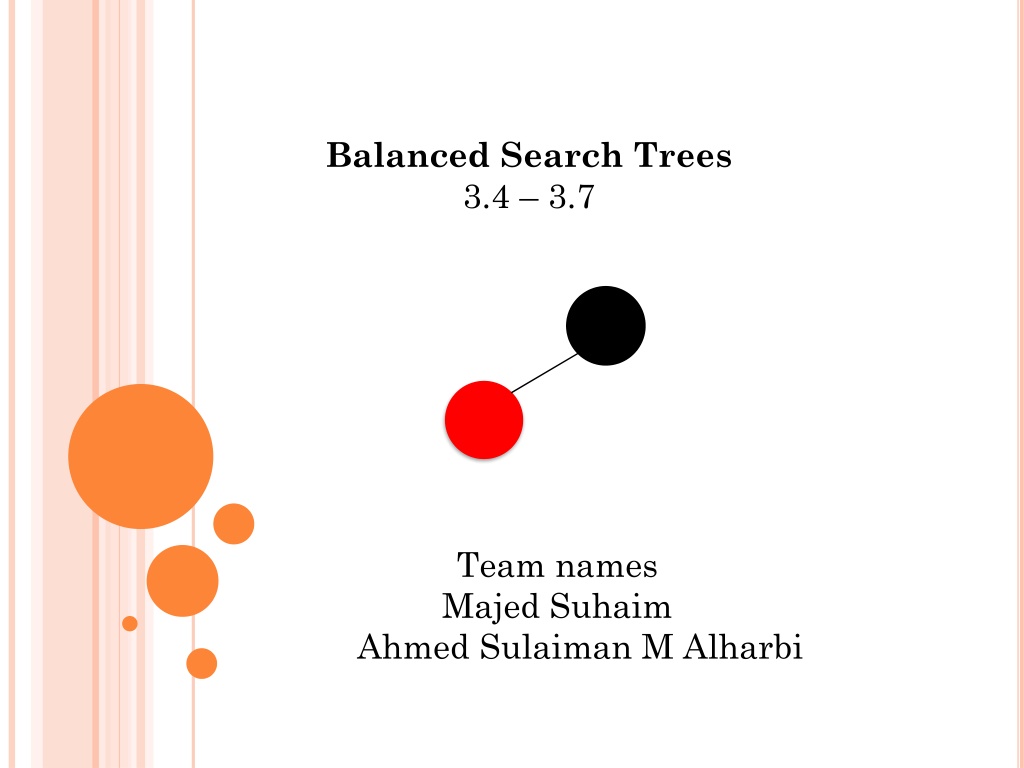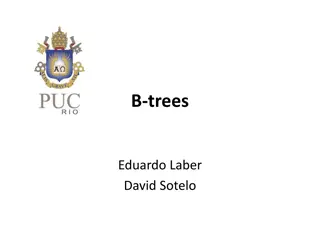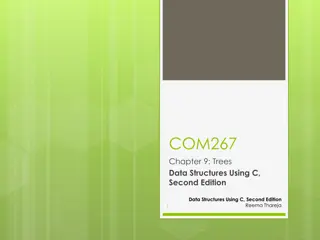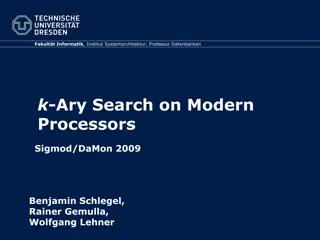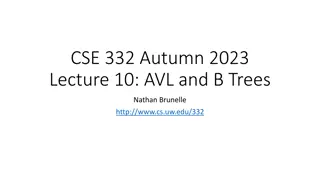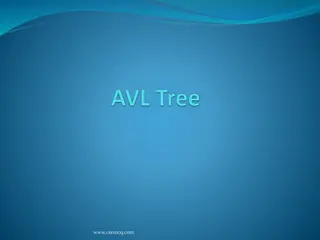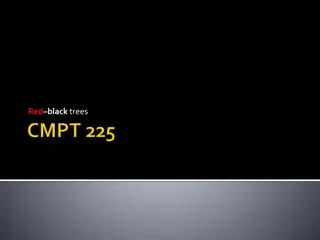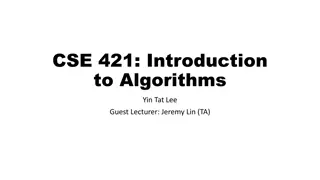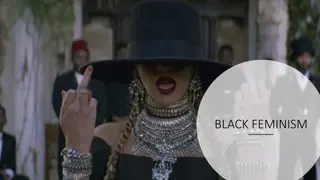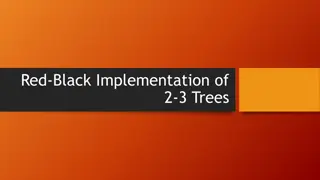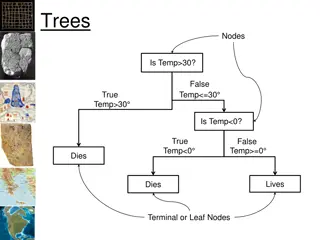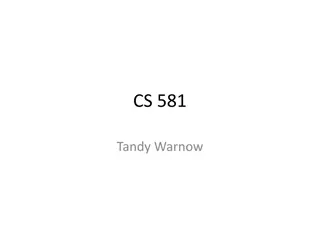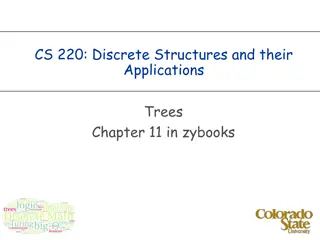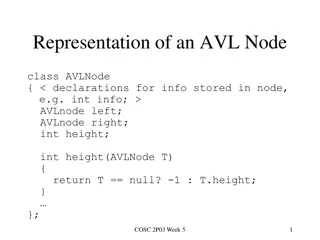Balanced Search Trees and Red-Black Trees
Balanced Search Trees ensure efficient data retrieval by maintaining balancedness properties within the tree structure. Red-Black Trees are a type of binary search tree with specific coloring rules that help in balancing and efficient searching. Learn about the structure, properties, and worst-case height of Red-Black Trees, along with the concept of black-height and height-balanced trees. Discover the importance of rotations in maintaining the order of keys in a search tree and the re-balancing process for Red-Black Trees.
Download Presentation

Please find below an Image/Link to download the presentation.
The content on the website is provided AS IS for your information and personal use only. It may not be sold, licensed, or shared on other websites without obtaining consent from the author.If you encounter any issues during the download, it is possible that the publisher has removed the file from their server.
You are allowed to download the files provided on this website for personal or commercial use, subject to the condition that they are used lawfully. All files are the property of their respective owners.
The content on the website is provided AS IS for your information and personal use only. It may not be sold, licensed, or shared on other websites without obtaining consent from the author.
E N D
Presentation Transcript
Balanced Search Trees 3.4 3.7 Team names Majed Suhaim Ahmed Sulaiman M Alharbi
RED-BLACK TREES Definition: a binary search tree with nodes colored red and black such that: the paths from the root to any leaf have the same number of black nodes, there are no two consecutive red nodes, If a node is red, then both of its children are black the root is black.
A red-black tree of height for h even and h odd The total number of leaves is of the form: 1 + 2i1 + 2i2 + 2i3 + +2ih , So for h even the number of leaves is: 1 + 2(20 + 21 + 22 + +2(h/2) 1) = 2(h/2)+1 1, and for h odd it is: 1 + 2(20 + 21 + 22 + +2((h 1)/2) 1) + 2(h 1)/2 = 3 22(h 1)/2 1 So the worst-case height of a red-black tree is really 2 log n O(1).
The height of red-black tree Definition: The black-height of a node, x, in a red-black tree is the number of black nodes on any path to a leaf, not counting x. Black-Height of the root = 2
Height-balanced trees We have to maintain the following balancedness property - Each path from the root to a leaf contains the same number of black nodes bh =2 7 3 18 bh =2 bh =1 10 bh =1 22 bh =1 11 8 26 bh =1 bh =1
Rotation A rotation is a local operation in a search tree that preserves in-order traversal key ordering.
Bottom-Up Rebalancing for Red-Black Trees * The idea for insertion in a red-black tree is to insert like in a binary search tree and then reestablish the color properties through a sequence of recoloring and rotations The rules are as follows: 1. If other is red, color current and other black and upper red. 2. If current = upper->left 2.1 If current->right->color is black, perform a right rotation around upper and color upper->right red. 2.2 If current->right->color is red, perform a left rotation around current followed by a right rotation around upper, and color upper->right and upper->left black and upper red. 3. If current = upper->right 3.1 If current->left->color is black, perform a left rotation around upper and color upper->left red. 3.2 If current->left->color is red, perform a right rotation around current followed by a left rotation around upper, and color upper->right and upper->left black and upper red.
* We have 3 cases for insertion Case 1: Recolor (uncle is red) G G P P U U
Case 2: Double Rotate: X around P then X around G. Recolor G and X X G P P U G X S U S
Case 3: Single Rotate P around G Recolor P and G G P P U X G S X S U
Analysis of Insertion - A red-black tree has O(log n) height - Search for insertion location takes O(log n) time because we visit O(log n) nodes - Addition to the node takes O(1) time - Rotation or recoloring takes O(log n) time because we perform * O(log n) recoloring, each taking O(1) time, and * at most one rotation taking O(1) time - Thus, an insertion in a red-black tree takes O(log n) time
Deleting a node from a red-black tree is a bit more complicated than inserting a node. - If the node is red? Not a problem no RB properties violated - If the node is black? deleting it will change the black-height along some path
* We have some cases for deletion P delete U S V Case A: - V s sibling, S, is Red Rotate S around P and recolor S & P
S P Rotate S around P P S V V S Recolor S & P P V
P delete S U V Case B: - V s sibling, S, is black and has two black children. Recolor S to be Red Red or Black and don t care
Recolor S to be Red P P S S V V
P S delete U V Case C: - S is black S s RIGHT child is RED (Left child either color) Rotate S around P Swap colors of S and P, and color S s Right child Black
S P Rotate S around P P S V V S P Recolor: Swap colors of S and P, and color S s Right child Black V
P delete S U V Case D: - S is Black, S s right child is Black and S s left child is Red i) Rotate S s left child around S ii) Swap color of S and S s left child
P P S V V P S Rotate S s left child around S V S Recolor: Swap color of S and S s left child
Analysis of deletion - Ared-black tree has O(log n) height - Search for deletion location takes O(log n) time - The swaping and deletion is O(1). - Each rotation or recoloring is O(1). - Thus, the deletion in a red-black tree takes O(log n) time
RED BLACK TREES Top-Down Insertion
REVIEWOF BOTTOM-UP INSERTION In B-Up insertion, ordinary BST insertion was used, followed by correction of the tree on the way back up to the root This is most easily done recursively Insert winds up the recursion on the way down the tree to the insertion point Fixing the tree occurs as the recursion unwinds
TOP-DOWN INSERTION STRATEGY In T-Down insertion, the corrections are done while traversing down the tree to the insertion point. When the actual insertion is done, no further corrections are needed, so no need to traverse back up the tree. So, T-Down insertion can be done iteratively which is generally faster
GOALOF T-D INSERTION Insertion is always done as a leaf (as in ordinary BST insertion) Recall from the B-Up flow chart that if the uncle of a newly inserted node is black, we restore the RB tree properties by one or two local rotations and recoloring we do not need to make changes further up the tree
GOAL (2) Therefore, the goal of T-D insertion is to traverse from the root to the insertion point in such a way that RB properties are maintained, and at the insertion point, the uncle is Black. That way we may have to rotate and recolor, but not propagate back up the tree
POSSIBLEINSERTIONCONFIGURATIONS X (Red or Black) Y Z If a new node is inserted as a child of Y or Z, there is no problem since the new node s parent is black
Possible insertion configurations X Y Z If new node is child of Z, no problem since Z is black. If new node is child of Y, no problem since the new node s uncle (Z) is black do a few rotations and recolor . done
POSSIBLEINSERTIONCONFIGURATIONS X Y Z If new node is inserted as child of Y or Z, it s uncle will be red and we will have to go back up the tree. This is the only case we need to avoid.
TOP-DOWN TRAVERSAL As we traverse down the tree and encounter this case, we recolor and possible do some rotations. X Z Y There are 3 cases. Remember the goal to create an insertion point at which the parent of the new node is Black, or the uncle of the new node is black.
CASE 1 XS PARENTIS BLACK P P X X Z Y Y Z Just recolor and continue down the tree
CASE 2 X s Parent is Red (so Grandparent is Black) and X and P are both left/right children Rotate P around G Color P black Color G red Note that X s uncle, U, must be black because it (a) was initially black, or (b) would have been made black when we encountered G (which would have had two red children -- X s Parent and X s uncle)
CASE 2 DIAGRAMS G P P U G X X S Z Z S U Y Y Rotate P around G. Recolor X, Y, Z, P and G
Case 3 X s Parent is Red (so Grandparent is Black) and X and P are opposite children Rotate P around G Color P black Color G red Again note that X s uncle, U, must be black because it (a) was initially black, or (b) would have been made black when we encountered G (which would have had two red children -- X s Parent and X s uncle)
CASE 3 DIAGRAMS (1 OF 2) G G X U P U P Z S X Y S Y Z Step 1 recolor X, Y and Z. Rotate X around P.
CASE 3 DIAGRAMS (2 OF 2) X G X U G P P Z Z U S Y Y S Step 2 Rotate X around G. Recolor X and G
TOP-DOWN INSERT SUMMARY Case 1 Recolor X,Y,Z P is Black P P Just Recolor X X Y Z Y Z Case 2 P is Red X & P both left/right Rotate P around G Recolor P,G P G G Recolor X,Y,Z G X P P Y Z X X Y Y Z Z G G X Case 3 P is Red X and P are opposite children Recolor X,Y,Z Rotate X around P G Rotate X around G Recolor X, G X P P P X Y Z Y Z Y Z
45 85
46 85
